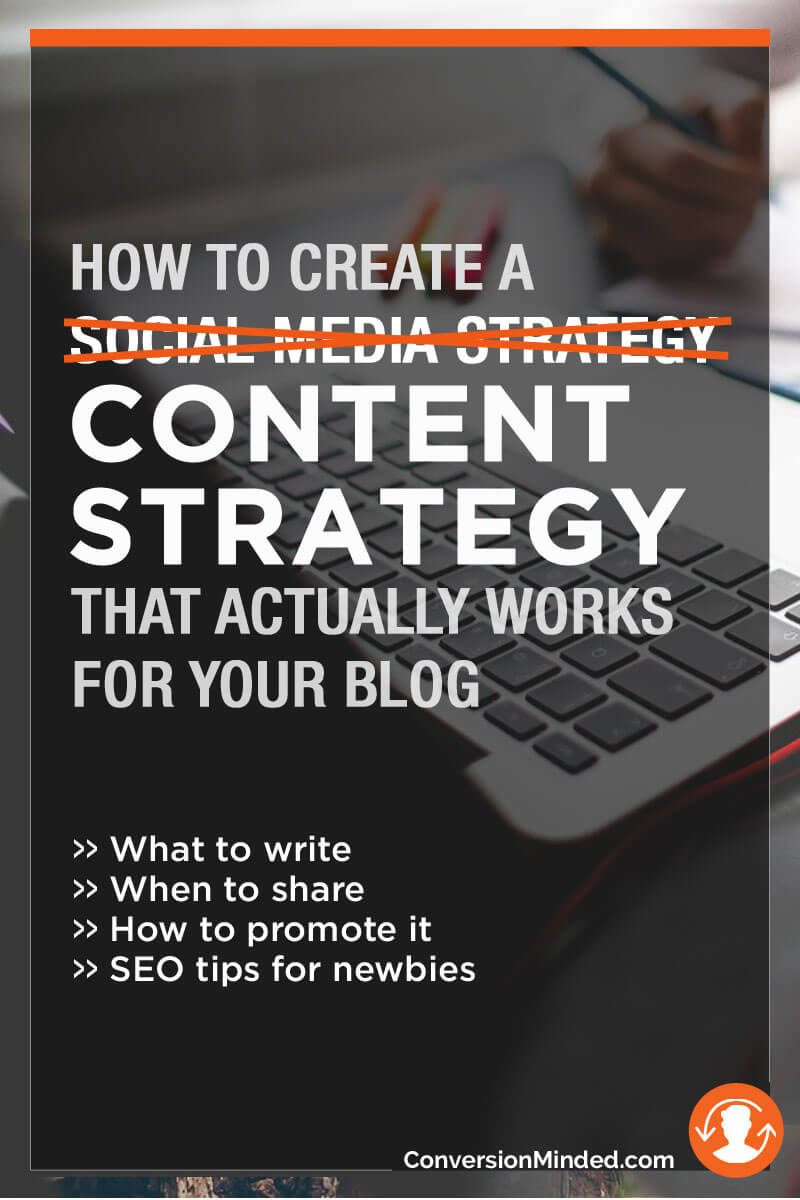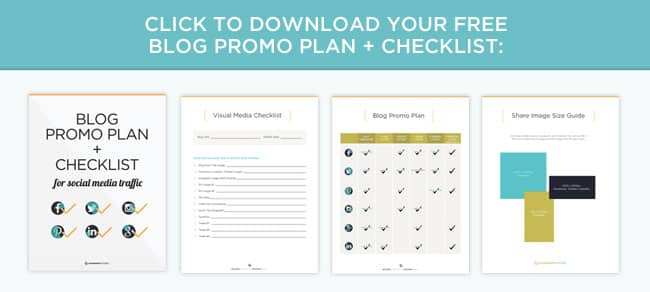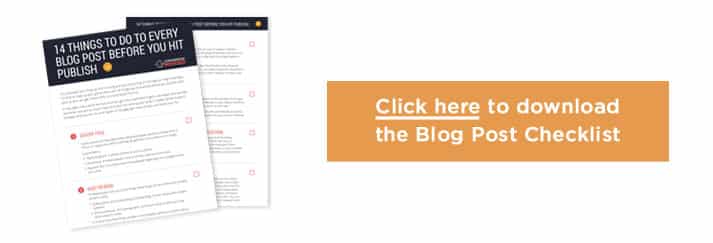How To Create a Content Strategy That Works for Your Blog
 When you’re just getting started with blogging, probably the most important thing you can do is just start.
When you’re just getting started with blogging, probably the most important thing you can do is just start.
Start writing.
Start publishing.
Start sharing.
It can be challenging enough to get into the routine of it all. And you push yourself because you know there are many reasons you want to be blogging. Here’s just a few:
- It can generate a huge amount of traffic to your business
- It can help you become an influencer, with the right network
- It can seriously boost your income and revenue
So with all that it can do for your business, why does it feel like you get sucked you into a rabbit hole every time you sit down to write? Where’s the real payoff?
The thing is this: without a strategy in place for your content, blogging can seem like a waste of time.
The good news is that it’s pretty easy to put a well-crafted content and social media strategy in place for your blog. Especially once you’ve written your first few posts.
In this post I’m going to explain why you need a content strategy for your blog, and simple ways to create one that works for your business:
1) Content is the New SEO
SEO, social media and content go hand in hand nowadays. You really can’t talk about one without talking about the other. Here’s why:
- Google continues to change its ranking algorithms in favor of valuable content that provides a great user experience, so black-hat SEO tactics like keyword stuffing and hidden text doesn’t work today. Instead, search engines look at the relevance and popularity of your content as primary ranking factors.
- Traffic from search engines isn’t the only way to generate a huge audience, which is where social media comes in. As a blogger and publisher, it’s amazing how you can leverage social media platforms to help people find your content and drive targeted traffic to your business.
The one thing that SEO and social media has in common is content. You need content for your keywords and search engines, and you need content for people on social media.
Content is the vehicle, and social media is the medium.
2) Content is How We Do Business
Consumer expectations are what’s really driving content marketing.
You can see the demand for content everywhere…trains, sidewalks, cafes, restaurants, nail salons, hair salons, parks, bus stops, the list goes on. Everywhere you go, people are buried in their phones and devices either on Facebook, Pinterest, or Google hunting for something they need.
They want access to the information they need, whenever they need it.
All of this means that as a blogger and business owner, you have to feed this “research-and-validate” mentality. The way to do that is by creating and publishing original content.
Content is how people do business. And it’s how people will find your blog.
3) Content Is Here to Stay
We’ve become a social world and that’s only going to continue to grow.
Especially given that social platforms are all mobile-friendly, and people can check out a pin, Facebook post, or tweet directly on their phone.
When you add in the fact that some big name employers are even implementing social “reputation scores” (similar to credit scores) as part of background checks during the interview process, social media isn’t going anywhere.
Since social media relies on content for its fuel, blogging isn’t going anywhere either.
4) Content Works For All Businesses
Here’s why:
It used to be that local businesses could rely on aggressive SEO tactics to rank high in Google. These were “black-hat” techniques that cared only about search engines, with a complete disregard for actual people.
All of that has changed and content is truly king when it comes to ranking in search engines.
Even B2B brands have integrated content into their sales processes.
Bottom line, people want authenticity and relevancy and that demand crosses over industries and business models. All of this comes in the form of content.
Here’s how to create a content strategy that works for your blog:
PART 1: LAYING A SOLID BRAND FOUNDATION
You’re blogging and you have some posts that you’ve started to share.
Before you move forward, now is a good time to plan ahead and tweak your blog’s brand based on what you’ve learned so far. It’s time to tighten things up so that you know exactly what content to create, why you’re creating it, and who you’re speaking to.
1) Who Are You Blogging For?
When I talk about branding your blog, I’m not talking about your logo, tagline, blog design, fonts, tagline or any visual elements right now.
I’m talking about positioning your blog, and that means knowing your audience way beyond things like their age, income or location. It’s one thing to know demographics and it’s another thing to know what their real motivations are for reading your blog.
You want to tap into how they’re really feeling. What does their day look like? What are they frustrated with right now? What do they want to be able to do? And most importantly, what are they saying around your brand?
Ask yourself these two questions:
- How do people FEEL before reading your post? How do they feel afterwards?
- What is an average DAY like for people before reading your blog? What is the average day like for them after they read it?
Answering these questions will give you clarity on the transformation that your blog provides for your readers.
This type of deep dive requires really listening to your audiences. A good way to do that is simply ask subscribers what they really want to know around your niche.
In my experience, inside your target audience you’ll probably have a couple of different “buckets” of people. You may have one group of people that are motivated by one thing and a second group that’s motivated by another thing entirely.
For instance, one of my clients is an online fitness coach and we discovered by asking and listening that there were four entirely different buckets of customers:
- Bucket A: want a fun, quick workout with amazing results
- Bucket B: want a safe workout that prevents injuries and pain
- Bucket C: want to stop taking medications for blood pressure and diabetes
- Bucket D: want a complete system of fitness and nutrition that’s done for them, where they don’t have to think
See how different people can have completely different pain points? People in Bucket A aren’t thinking about safety or even medications, they just want a fun workout. So blogging about blood pressure isn’t really going to capture their attention.
If you want, you can download this Blog Post Checklist, where I break down the blog post structure that will help more people find your posts on Google and social media:

2) Create Content Themes
The point is that they’re all having different conversations. Part of refining your blog’s brand is to take those separate conversations and develop content themes around them, with each theme speaking directly to the people in each bucket.
3) Map Out 2 Months of Posts
Once you have those themes, create an editorial calendar around each one. Maybe what you do is focus on one theme each month, so you can take readers on a journey with your posts. This will also help you come up with ideas around each theme that are related to each other.
I’ve found that 2 month’s worth of content at a time is enough. You can go for three, but usually by the time you’ve written content for 6-8 weeks, you have even more ideas and your topics will shift a bit. Plus this way you’re not overwhelmed.
PART 2: OPTIMIZE YOUR BLOG
It’s amazing how a few simple tweaks to your blog can be the difference between a little traffic and tons of traffic. Optimizing your blog for search engines AND for people will help you stay on top of your game and make sure every post reaches as many people as possible.
Here’s what you can do:
4) Add Social Engagement Elements
When you’re new to blogging, the best thing you can do is to make yourself available to people so they know that you’re a real person who wants to interact with them.
Here are some ways to make it easy for people to get to know you and get in touch with you:
- Add a contact page to your website with a form and let people know how to get in touch with you (email, phone, social profiles)
- Add share buttons at the beginning or end of your post and make your images shareable too. For more on this, check out this post.
- Add comments to your blog so you can start to build a relationship with your readers. Make it easy for them to leave their thoughts and opinions, and then respond to their comments to show them that you care about what they think.
5) Make it SEO-Friendly
You know you have great content on your blog. But beyond posting it to your social sites, it kind of seems like you’re the only one reading it, am I right?
This is where SEO comes in.
I know that keyword research and SEO seem overwhelming, but don’t let that stop you from giving your post a winning chance of getting found when people type in important terms related to it.
Here are some ways to make it easy for search engines to find your site:
- Use Google’s Keyword Planner to find popular keywords that don’t have a ton of competition. This just means you want a lot of monthly searches for the keyword with few competitors trying to rank for it. This will give you the best chance of ranking for that keyword.
- Install the Yoast SEO plugin for WordPress and add the keyword to your page title, description, subheadings, and a few times in the copy (it will red flag anything else to do)
- Add a featured image and other images to your post. Include the keyword in the name and in the alt text (make the names slightly different)
- Make it as long as you can. The reason is that Google sees longer posts as a signal of relevance, plus you have more room to weave in your keyword.
I recommend writing your post first, and then going back and adding your target keyword later. This way you can keep a flow going with your writing and it will sound more organic and authentic instead of sounding like you’re forcing it.
Related: The Ultimate Guide to SEO for Bloggers + Entrepreneurs
PART 3: DEVELOPING THE CONTENT STRATEGY
6) Offer a Content Upgrade
It’s a great feeling to write an in-depth and valuable blog post. Especially when your topic is something that took you a long time to figure out. You just know that your readers will benefit a lot from it and that following your tips is going to save them a lot of time and effort.
So why not let them download the post?
You can actually make this a part of your content strategy, where every time you write a detailed post, you copy it into Word and save it as a PDF. You don’t need a fancy design or anything more than a checklist or cheat sheet.
Include a link to it in your post with a simple call to action like, “Download this post as a PDF”.
Your readers get a perk because they have a resource they can reference when they need it, and you get a perk because you collect their contact info in exchange for the download.
7) Provide Real Value
I mentioned earlier that longer posts will help you rank higher in search engines, and there’s actually a way to control this even more.
That’s by creating epic content. I don’t really like this term, because it just kind of makes me scrunch my nose and go, “huh?” It also takes the focus away from what it really means, which is to create valuable content.
So your next questions are probably “What does valuable content really mean?“, and “How do I create it?”
Here’s a quick checklist that should help:
- More detailed. Make it an undeniable and in-depth resource that people can’t do without.
- Better. Research trending content around your keyword, find the gaps in what’s already out there, and then improve upon it.
- Longer. Long-form content isn’t really the end goal here. Just know that you can’t get away with 500-word posts any more. Google (and your readers) want long comprehensive posts.
- Be useful. I’m not talking a little useful. I’m talking life-changing useful. Solve a problem, help people save money, save time, or make something easy to do. Give them so much value that they can’t imagine not reading your content.
- Unique. Your experiences are what separate you from other bloggers, so make sure people feel you in the post. They’re looking to you to interpret information, not just present it. Bottom line, be a real person having real conversations.
8) Extend Conversations Into Future Posts
You put a lot of time into writing your blog post, so why not track how well it performs across your social networks?
Most of the scheduling automation tools mentioned earlier will provide analytics where you can see which of your posts are popular across each network. Most social media platforms provide this data too.
Keeping an eye on performance will help elevate your social media marketing because you can:
- Discover trends across your social networks
- Come up with future blog posts
- Know which posts aren’t as popular so you can focus your time on better ones.
There are several other ways you can track conversations that your audience is having online, including Reddit, forums around your topics, and comments on your actual blog posts.
If you track your social media analytics plus these other discussions that are happening online, you can spot questions and problems that keep coming up for people. Leverage that information to write your next blog post or for your editorial calendar.
9) Repurpose your Content
You accomplished so much by writing your blog post, and now you’re probably thinking “How can I reach even more people with it?”
That’s where repurposing comes in.
Repurposing your blog post just means packaging it up differently for a new medium and user, such as a YouTube video or an infographic.
Repurposing gives you a chance to have an even greater impact on your readers, so long as you don’t overdo it. Not every post is a good candidate. You want to add another level of value and not just duplicate your content. Make sure people will experience something new.
When you upload a video or create a podcast, add a link back to your post for even more traffic to your site.
If you want to get massive traffic to your posts, I created a blog promo cheat sheet to help you plan what you need to share, and when, so that your legendary content gets found by people ev’rywhere on social media.
Click the image below to download your blog promo planner.

PART 4: DEVELOPING YOUR SOCIAL MEDIA STRATEGY
You have engaging and easy-to-read blog posts that are ready to be shared across social media.
To get your content on social media where people are talking about it and to get people interacting with your posts, follow these tips.
10) Create Profiles Everywhere
You’re probably thinking Facebook, Google+, Pinterest, Twitter and maybe LinkedIn when I say that. The truth is that there are so many sites out there and if you really want to leverage social media for traffic, you should consider creating a presence on other ones too.
Besides the obvious ones, here are some other places to create profiles:
11) Choose a Few Channels And Dig In
Now that you have a presence of all of these channels, it’s time to really dig in, right?
Hmmm, maybe not so fast.
Building a following on social media takes time, and the last thing you want to do is to try to be everywhere at the same time. It’s one thing to share your posts everywhere (Reddit, BizSugar and others mentioned earlier), and another thing to create a community on each one.
Focus on two or three channels where your customers show up, and then commit to showing up regularly there too.
For example, if your target audience is women, Pinterest and Instagram may be a good place for you. If you’re a web-based business, Twitter and Facebook may work well, and if you sell to professionals, try LinkedIn or Google+.
If you want some insight into each channel, BuzzSumo is a great tool where you can see the most popular content around your keyword, sorted by platform. It’s also a great way to get future blog ideas!
12) Promote Your Content
Now you’ve got all the right elements to your post to get more eyes on it, but still that’s only half the battle. You have to hustle your posts if you want to see a real bump in traffic.
Right after you publish your post, follow this sequence to share it:
- Google+ personal profile
- Twitter personal profile
- Facebook personal profile
- Facebook Groups (if any)
- LinkedIn Groups
- Other Twitter profiles
- Facebook Page
- Google+Page
- LinkedIn Company Page
- The other sites I mentioned (Reddit, BizSugar, etc)
Related: 32 Insanely Easy Ways to Boost Your Blog Traffic for Free
13) Automate Your Posts
After you share your post the first time, why not use social media tools to get even more exposure and reach even more people? With so much content out there, you’ll want to post it a few times beyond the initial share to get the most eyes on it.
You can schedule additional shares, pins and tweets to go out throughout the week, and even a month or two months later. This way you’re constantly sharing a mix of fresh and older content so people have a good chance of seeing it.
These sites will help you schedule your posts on popular social media sites and pick the days/times you want to share them:
- Hootsuite
- Buffer
- SocialOomph
- Meet Edgar
While you’re at it, why not use these tools to share other people’s content too? It will help you build up a social following and help you round out your overall content strategy.
Oh, and if you’re on a tight budget or just don’t want to pay monthly fees to automate social media, there’s a brilliant way to do virtually the same thing using IFTTT and Google Calendar, absolutely free! You money-saver, you!
14) Know The Best Time to Share
Timing when you share your posts around when people are most active will help you get as many eyes on it as possible.
For example, Twitter users are more active in the afternoon, Google+ users generally prefer the morning, and Facebook and Pinterest users are all about the weekends.
Test each site and then use the social automation tools mentioned earlier to time your shares perfectly and get a leg up on your competition.
Related: Why You Need a Social Media Strategy and How to Create One That Works
15) Build a Following
The big thing about building a following is that you can become an influencer, just like the influencers you like and follow. “Influencer” just means that you have a big enough following where you don’t need other forms of traffic like SEO and paid media.
For example, the banking firm Goldman Sachs has such a huge fan base that it now relies solely on its own social platforms for things like press releases and updates.
The key is that when you have a following, you have your own traffic source. Pretty powerful stuff, huh?
Start by following other people in your niche. Many of them will follow you back. On sites like Facebook, you’ll probably need paid ads to promote your content and grow your following that way.
16) Connect With Influencers
A great way to start building your following is simply by following expert bloggers or “influencers” in your niche. Some of them may follow you back and even help boost the traffic and social shares to your blog.
You can also learn a lot from them by seeing how they use social media to their advantage, what types of posts they share and which ones get the most engagement. Even just seeing how frequently and at what times they post will give you an idea of how often you need to share content.
Bonus if you mention an influencer in your actual blog post and then tag them with a link to your post. Who knows? They may share it with their followers too.
Just be careful not to spam timelines. You need to have the appropriate context to tag them.
For instance, if you just briefly mention them and then tag them, this would not be inappropriate. Make sure it really relates to your post and is something substantial, like if you wrote about them extensively or if you know it’s something they would want to read. If this is the case, you can go ahead and tag or @mention their name.






